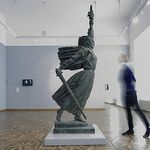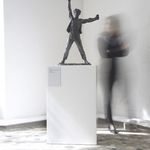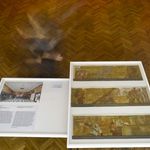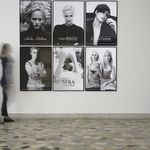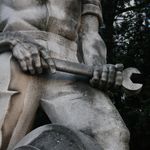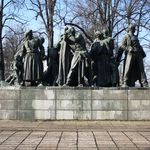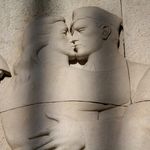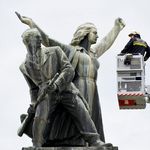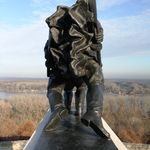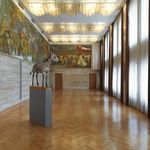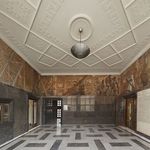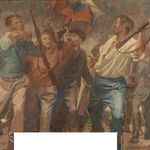Heroes We Love
HEROES WE LOVE
socialist realism revised
case study: ex-Yugoslavia
UGM | Maribor Art Gallery, Strossmayerjeva 6
Opening: Friday, 20 March 2015, at 19:00
artists: Antun Augustinčić (CRO), Vojin Bakić (CRO), Jasmina Cibic (SLO), Lojze Dolinar (SLO), Igor Grubić (CRO), Boža Ilić (SRB), Sanja Iveković (CRO), Boris Kalin (SLO), Zdenko Kalin (SLO), Nikola Kečanin (CRO), Anton Gojmir Kos (SLO), Tone Kralj (SLO), Frano Kršinić (CRO), Siniša Labrović (CRO), Luiza Margan (CRO), Dalibor Martinis (CRO), Vinko Matković (CRO), Ivan Mirković (CRO), Slavko Pengov (SLO), Tadej Pogačar (SLO), Arjan Pregl (SLO), Karel Putrih (SLO), Vanja Radauš (CRO), Ivan Meštrović (CRO), Radeta Stanković (SRB), Sreten Stojanović (SRB).
curators: Simona Vidmar & Miško Šuvaković
The relatively unknown period of socialist realism in Slovenia and in the broader region of the former Yugoslavia was a time of generous commissions and unrestrained socialist iconography, a time of heroic enthusiasm and monumental propaganda. It was the last artistic period of uncensored manifest power, when the state was its sole consumer and commissioner. Socialist realism was marked as doctrinal art in the service of the party, an eclectic and academic artistic configuration, a conservative, anti-avant-garde stream, and an art of empty visualization and false sentiments. Majestic monuments and monumental sculptures, heroic murals and enormous canvases of socialist realism ended, as is characteristic for political transitions and running largely parallel with their initiation, in the dustbin of history. Ridiculed, hidden or forgotten they reside anonymously, in silent conformity with the largely unquestioned canon of the history of art.
Heroes We Love enters a controversial field of socialist heroic art in order to identify and acknowledge those protagonists who brought the monumental art of the preset political landscape to its peak. We are interested in the iconography of socialist realism in all its mighty, generous, heroic realizations; in its sentiments, repartee, and feeling of drama, its large-scale commissions and more. We wish to understand how far revolutionary romanticism went, from what and where it drew, and how it imploded into itself. Monuments as constructions of time and space simplify and fabricate a particular history. The question here is, whether this monumental socialist art is also capable of creating history − a history of art. Walter Benjamin wrote that "there has never been a document of culture, which is not simultaneously one of barbarism" that needs to be understood as "a tool of the ruling classes." Similarly, the monuments of socialist realism too bear witness to recent culture – and barbarism. It is time to recognize them!
Five selected examples of socialist realism drawn from the region of former Yugoslavia formed the initial central concept of the exhibition: the Soviet-inspired Monument to the Red Army Fighters by Croatian sculptor Antun Augustinčić (1945−47, Batina, CRO); the heroic mural The Fight of Yugoslav Nations for Freedom and Renewal of the Country by painter Slavko Pengov (1947, Villa Bled, SLO); the monumental figural character of the Monument to Resistance and Torment by sculptor Lojze Dolinar (1946−50, Kraljevo, SRB); the double relief of the Tomb of the Liberators of Belgrade by Serbian sculptor Rade Stanković (1954, Belgrade, SRB); and the unrealized Monument to Marx and Engels by Croatian sculptor Vojin Bakić (1950−53). These five works exemplify the period from which they come and refer to. They narrow the period down, from 1945 to 1955 –the first post-war years under the strong influence of the Soviets and agitprop respectively (until 1948), to the time of the mid-1950s, when heroic realism still prevailed in art. These five examples cover all of the major narratives of socialist art: resistance, suffering, victory, builders, and the cult of personality; and cover all of the art history genres: murals, reliefs, figural compositions, and isolated figures. These examples have been selected so as to order and follow the formal development of the visual language of socialist realism: from the strict imitation of Soviet examples to fierce realism and deviations from exercises of simplification and investigations into plasticity. A network of models, influences, parallels and divergences revolves around these five examples, so as to represent some 40 works of art by 25 artists. In order to introduce a linking thematic line in researching socialist realism and the broader field of art and ideology we introduce reflections, enactments, actions, and interventions by contemporary artists today, with a view to moving away from monuments of failed revolutions to strive instead toward new artistic utopias and contemporary concepts of memory patterning. Or to quote Deleuze and Guattari: "The monument is not something commemorating a past; it is a bloc of presentations that owe their presentation only to themselves."
Maribor Art Gallery is proud to announce that the coming exhibition is part of the larger international project “Heroes We Love. Ideology, Identity and Socialist Art in New Europe”, supported by the European program Creative Europe 2014−2020. In the period 2015−2017, the project will deal with the legacy of socialist art in New Europe and focus on the most important art-related issues, problems and opportunities of the period as well as produce a series of exhibitions, public art interventions, and international conferences and workshops.
"Heroes" brings together nine partners from Central and Southeastern Europe, from Poland to Albania: Maribor Art Gallery (leading partner); BLOK Association (CRO); SCCA Contemporary Art Center Sarajevo (BiH); Tirana Art Lab (Albania); Laznia Center for Contemporary Art, Gdansk (Poland); IEFSEM Institute of Ethnology and Folklore Studies with Ethnographic Museum, Sofia (Bulgaria); Museum of Yugoslav History (SRB); University of Primorska (SLO); Cultural Association Center plesa, Maribor (SLO).
external experts: Marina Benažić, dr. Nikola Dedić, Meta Gabršek Prosenc, Maro Grbić, Ivana Hanaček, Breda Kolar Sluga, Jure Kirbiš, dr. Vladimir Kulić, Lana Lovrenčić, dr. Lidija Merenik, Katarina Mohar, Nataša Ivančević, Donovan Pavlinec, Božidar Pejković, Tihana Pupovac, Jožica Šparovec, Simona Šuc, dr. Milanka Todić, dr. Neda Todorović Uzelac, mag. Davorin Vujčić.
collaborating institutions: Archives of Yugoslavia, Tošo Dabac Archive, Antun Augustinčić Gallery, Glyptotheque of the Croatian Academy of Sciences and Arts, Museum of Gorenjska, Bjelovar Municipal Museum, Museum and Galleries of Ljubljana, Museum of Yugoslav History, National Museum of Contemporary History, National Gallery of Slovenia, National Museum Kraljevo, Koper Regional Museum, Regional Archives Maribor, Croatian State Archives, The Serb National council.
graphics & exhibition design: Ajdin Bašić
assistant curator: Jure Kirbiš
WE WARMLY INVITE YOU TO ATTEND!
Supported by:







